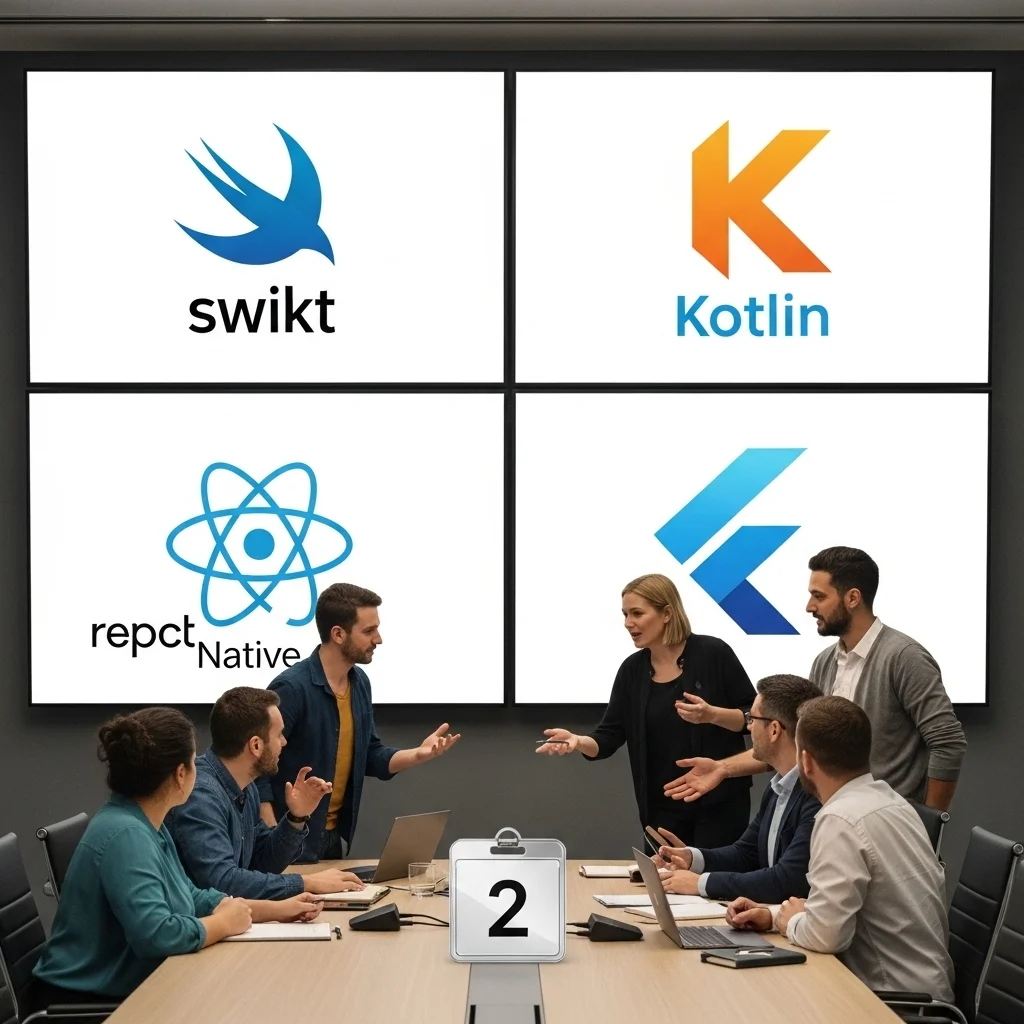What will it deliver?
Four concrete benefits you'll notice tomorrow
Automate
Bespoke processes move from Excel and email to a single app. Fewer errors, less frustration, more time for work that matters.
Integrate
We link your new mobile app directly to existing APIs or ERPs. Your data remains a single source of truth, helping you sleep better at night.
Scale
Thanks to cross-platform frameworks we maintain one codebase for iOS and Android. Updates roll out simultaneously—without double costs.
Innovate
Our AI-driven components spot usage patterns. We translate those insights into new features before the competition even wakes up.

The Swiss Army knife principle explained
You carry it everywhere, use only one or two functions a day, yet at crucial moments that knife suddenly becomes indispensable. A mobile app works exactly the same. Below we show how Spartner keeps that blade razor-sharp—and why clients often return after the first release to add extra tools to the same handle.
Sharpness first, then shine
Practice shows that a minimal viable product is less about features and more about focus. What I observe is that teams who start with a strictly defined core iterate faster later on.
Continuous honing with data
We integrate Firebase or App Center so real-time statistics pour in. At a glance you see which screens snag and which flows leak.
Small iterations prevent expensive refactors
One shared backlog keeps everyone on course
Automated builds shorten the "idea-to-app-store" cycle
How do we navigate your app journey?.
Theory is fine, but value emerges in execution. Follow these four steps for a flawless mobile launch.

Step 1 — Concept & validation.
Before we touch a single line of code, we test assumptions. Interviews, sketches, sometimes even a cut-out cardboard mock-up: whatever it takes to see whether the target user is actually waiting for it.

Step 2 — Choose architecture.
Native Swift/Kotlin? React Native? Flutter? There is no holy grail, but there is a best choice for your context. We lay the options side by side, including maintenance impact and community support.
Sub-step: Co-design security — OAuth2, Keychain, biometric login — we safeguard it from the start.

Step 3 — Build & integration.
This is where the magic happens. Thanks to AI-assisted coding we generate repetitive boilerplate so developers can focus on business logic. In practice this often saves 20–25% development time—subject to complexity, of course.

Step 4 — Test, refine, deploy.
We automate unit, UI and smoke tests. Then we push in one go to TestFlight, Google Play Internal Testing and—for the web variant—to a staging URL. Learn, tweak, go live.


Ready to accelerate mobile?
Leave your details or simply give us a call. We will brainstorm freely about what "having a mobile app built" can mean for your business. No sales pitch, just an honest conversation about opportunities, pitfalls and the fastest route to impact.

A philosophical view on mobile
Why an app is more than software
A mobile app is an extension of human behaviour. People reach for their phone reflexively when bored, in need or curious. As I mentioned earlier, this creates an opportunity to position processes very close to the user.
The device as context
Sensors, GPS, camera, haptic feedback—these features turn a smartphone into a context machine. Used well, an app feels almost personal.
The ethics of push
Notifications are powerful but addictive. We apply "notify only when helpful" so we do not create irrelevant noise.

Practical tips for your briefing
How your project document moves with the sprint
Describe one main use case in "I want to…" format
Add wireframes, even if they are pencil scribbles
List external systems with contacts
Think about support scenarios: what if something breaks?
Budgeting without a crystal ball
We often work with a feature estimate plus a change buffer. That said, no two projects are identical.
Reusing design tokens
Choose colours, typography and spacing in design tokens so both the web and mobile app keep exactly the same look, strengthening your brand.

Looking ahead to 2025 and beyond
Three trends you can leverage today
AI-powered personalisation
On-device machine-learning models enable offline personalisation. Think of health apps that analyse patterns locally.
Super apps in Europe
They are already huge in Asia; Europe is now opening up to niche super apps. Opportunities exist for sectors such as mobility and energy.
Instant-install WebApps
Google is pushing Progressive Web Apps even harder. For certain use cases, the need to budget separately for "building an iOS app" and "building an Android app" disappears.
Why should I have a mobile app developed if I already have a responsive website? 🙂
A website is fine for search traffic and occasional use, but it lacks device features such as push notifications and offline storage. An app sits literally on the user's home screen and shortens the distance between action and result. In addition, biometric login lowers the barrier for repeat use.
Is cross-platform always cheaper than native? 🤔
Not necessarily. Cross-platform saves on duplicated code, but some complex hardware features still require native modules. We first analyse your backlog, then choose the most cost-efficient route.
How long does it take before my app is in the App Store? ⏳
Apple's review can take anywhere from 24 hours to a week, depending on the workload and whether your app falls into sensitive categories. By following their guidelines early you avoid rejections.
Can I add a WebApp version later on? 💡
Absolutely. In fact, we account for it from day one. With a shared API layer you can translate functionality to the web without rewriting business logic.
How much does mobile app development cost at Spartner? 💶
We deliberately do not give standard prices—every app is unique. During a free consultation we outline realistic ranges, including maintenance.
Can I prioritise features myself during the build? 🙌
Please do. We work in short sprints in which you provide feedback after each iteration. This keeps the project aligned with your business goals.
How secure is an app with AI components? 🔐
AI adds no extra risk when you have the basics in place: encrypted storage, secure models and clear data flows. We use privacy-by-design as a foundation.
What if I want extra platforms, like wearables? ⌚
We build modularly. Parts of the code—authentication, data modelling—can be reused for watchOS or Wear OS. Saves time and money.










.webp)
